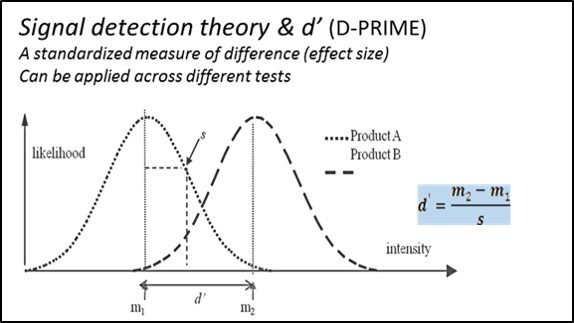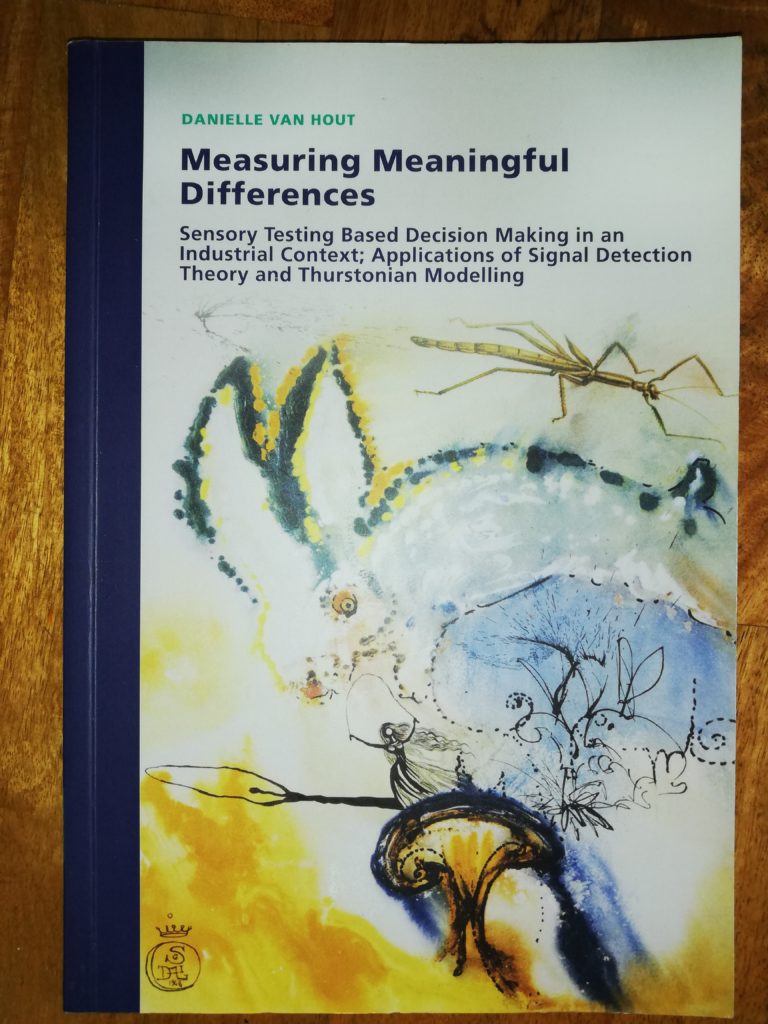SCIENTIFIC RESEARCH
Applied sensory psychophysics to explore and create ecologically valid and robust consumer research methods and effective sensory analytical test & data analysis methods.
RESEARCH TOPICS AND PUBLICATIONS
effective discrimination tests
- Lee, H-S., & Van Hout, D. (2009). Quantification of sensory and food quality: The R-index analysis. Journal of Food Science, 74, 57-64.
- Van Hout, D.H.A. (2014). Measuring meaningful differences. Sensory testing based decision making in an industrial context; applications of signal detection & Thurstonian modelling. PhD thesis, Erasmus University Rotterdam, Research Institute of Management, January 2014
- Choi, Y-J., Kim, J-Y, Christensen, R.H.B., Van Hout, D.H.A. & Lee, H-S. (2014). Superior performance of constant-saltier-reference DTF and DTFM to same-different tests by consumers for discriminating products varying sodium contents. Food Quality and Preference, 37 p. 100- 108.
- Jeong, Y-N, Van Hout, D.H.A., Groeneschild, C.A.G., and Lee, H-S. (2017). Comparative categorization method: Using 2-AFC strategy in constant-reference duo-trio for discrimination of multiple stimuli from a reference. Food Quality & Preference, 62, 284-296
SIGNAL DETECTION MODELS
- Stocks, M.A., Van Hout, D.H.A., & Hautus, M.J. (2013). Cognitive decision strategies adopted by trained judges when discriminating aqueous solutions differing in the concentration of citric acid. Journal of Sensory Studies, 28, 217-229.
- Stocks, M.A., Van Hout, D.H.A., and Hautus, M.J. (2014). Cognitive decision strategies adopted by trained judges in reminder difference tests when tasting yoghurt, mayonnaise, and ice tea. Food Quality and Preference, Volume 34, 14–23
- Stocks, M.A., Shepherd, D. Lee, H.-S., Van Hout, D., and Hautus, M.J. (2017). Cognitive decision strategies adopted by consumers in reminder difference tests when tasting mayonnaise and ice tea: Influence of the Authenticity test. Food Research International, 97, 265-271
- Hautus, M.J., Van Hout, D., Lee, H.S., Stocks, M.A., & Shepherd, D. (2018). Variation of d’ estimates in two versions of the A-Not A task. Journal of Sensory Studies, DOI: · 10.1111/joss.12470.
- Hautus, M.J., Van Hout, D., Lee, H.S., Stocks, M.A., & Shepherd, D. (2019). Observed discriminability is more variable than predicted by signal detection theory. Food Quality & Preference, DOI: 1016/ j.foodqual. 2019.103774.774

IMPROVING TEST PERFORMANCE
- Kim, M-A., Chae, J-E., Van Hout, D.H.A., & Lee, H-S. (2011). Discriminations of the A-Not A difference test improved when “A” was familiarized using a brand image. Food Quality and Preference, 23, 3-12.
- Kim, M-A., Chae, J-E., Van Hout, D.H.A., & Lee, H-S. (2014). Higher performance of constant- reference duo-trio incorporating affective state of mind in comparison with balanced- reference triangle test. Food Quality and Preference, 32, 113-125.
- Kim, M-A, Dessirier, J-M, Van Hout, D.H.A., and Lee, H-S. (2015). Consumer context-specific sensory acceptance tests: effects of a cognitive warm-up on affective product discrimination. Food Quality and Preference, 41, 163-171

NOVEL CONSUMER RESEARCH METHODS
- Kim, M-A., Van Hout, D.H.A., Dessirier, J.-M., & Lee, H-S. (2018). Degree of satisfaction-difference (DOSD) method for measuring consumer acceptance: A signal detection measurement with higher reliability than a hedonic scaling. Food Quality and Preference, 63, 28-37
- Kim, M-A, Van Hout, D.H.A., and Lee, H-S. (2018) Degree of satisfaction-difference (DOSD) method for measuring consumer acceptance: Comparative and absolute measures of satisfaction based on signal detection theory. Food Quality & Preference, 68, 167-172
- Kim, Min-A, Van Hout, Danielle. Zandstra, Elisabeth. and Lee, Hye-Seong. (2019) Consumer acceptance measurement focusing on a specified sensory attribute of products: Can the attribute-specified degree of satisfaction difference (DOSD) method replace hedonic scaling? Food Quality & Preference, 75, 198-208.
- Kim, I.-A., van Hout, D., & Lee, H.-S. (2015). Development of a consumer-relevant lexicon for testing kitchen cleansers considering different product usage stages. Journal of Sensory Studies, 30, 448–460.
- Kim, I.-A., Hopkinson, A., van Hout, D., & Lee, H.-S. (2016). A novel two-step rating-based ‘double-faced applicability’ test. Part 1: Its performance in sample discrimination in comparison to simple one-step applicability rating. Food Quality and Preference, 56, 189–200.
- Kim, I.-A., Hopkinson, A., van Hout, D., & Lee, H.-S. (2017). A novel two-step rating-based ‘double-faced applicability’ test. Part 2: Introducing a novel measure of affect magnitude (d’A) for profiling consumers’ product usage experience based on signal detection theory. Food Quality and Preference, 59, 141-149.
- Kim, I.-A., van Hout, D., & Lee, H.-S. (2018). Signal detection-based satisfaction measure of the holistic product usage experience with and without the ‘double-faced applicability’ test. Food Quality and Preference, 68, 40-49.










